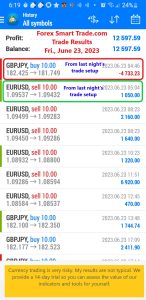And when it comes to evaluating the strength of a trend, the Average Directional Index is a popular technical indicator for this purpose.
The Average Directional Index, or ADX for short, is another example of an oscillator.
ADX fluctuates from 0 to 100, with readings below 20 indicating a weak trend and readings above 50 signaling a strong trend.
The ADX calculation can be complicated, but in a nutshell, the stronger the trend, the higher ADX goes
When the ADX is low, it highlights periods when the price is usually going sideways or trading in a range.
When the ADX has risen above 50, this indicates that the price has picked up momentum in one direction.
Unlike Stochastic, ADX does NOT determine whether the trend is bullish or bearish. Rather, it merely measures the strength of the current trend.
Because of that, ADX is typically used to identify whether the market is ranging or starting a new trend.
We consider ADX a “non-directional” indicator. It is based on comparing the highs and lows of bars and does not use the close of the bar.
The stronger the trend, the larger the reading, regardless of whether it is an uptrend or downtrend.





